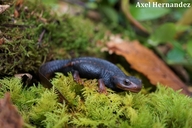|
Tylototriton shanorum Nishikawa, Matsui & Rao, 2014
Taunggyi Crocodile Newt Subgenus: Tylototriton | family: Salamandridae subfamily: Pleurodelinae genus: Tylototriton |
| Species Description: Nishikawa K, Matsui M, Rao D 2014 A new species of Tylototriton (Amphibia: Urodela: Salamandridae) from central Myanmar. Nat Hist Bull Siam Soc 60: 9-22. | |
 © 2019 Axel Hernandez (1 of 1) |
|
|
|
Description Tylototriton shanorum can be differentiated from members of the subgenus Yaotriton by the former having color on the lip, parotoid, vertebral ridge, ribe nodules, limbs, and the lateral sides of the tail. Within the subgenus Tylototriton, which T. shanorum is a member of, it can be differentiated from T. daweishanesis and T. v. verrucosus because the former has ventral markings while the two latter species do not. However, darker specimens of the focal species can also be further distinguished by having a narrow, weakly segmented dorsal ridge and more indistinct dorsolateral bony ridges on the head. From T. kweichowensis and T. pseudoverrucosus our focal species can be differentiated by having isolated markings on its rib nodules. From T. taliangensis our focal species can be differentiated by having distinct rib nodules and not having reddish markings on the posterior sides of the parotoids. The color of T. shanorum is duller than T. uyenoi, T. v. pulcherrima, and T. yangi, however bright-colored individuals of the focal species can be differentiated from T. uyenoi by having deep vomerine tooth series (Nishikawa et al. 2014). Tylototriton shanorum has 14 dorsal warts, which is two less than T. himalayanus. Tylotriton shanorum also has a smaller snout-vent length and greater head width to length ratio than T. himalayanus (Khatiwada et al. 2015). In alcohol, T. shanorum has a dark brown to black dorsal ground color and is slightly lighter on the ventrum. The anterior region of the head, parotoid, vertebral ridge, rib nodules, limbs, and lateral sides of tail are a dull reddish brown color. The upper and lower lips, palms and soles, vent region, and ventral side of tail are dark yellow (Nishikawa et al. 2014). Two juveniles that were bred in captivity and collected from the pet trade were initially suspected to be T. shanging but were later reclassified as T. shanorum based on molecular data (see Comments section). Like the adults they had dark brown to black dorsums with lighter ventrums. However, they had a brighter yellow color on the dorsal head, upper and lower lips, parotoid, vertebral ridge, rib nodules, limbs, palm and sole, vent region, and whole tail. It is unclear if this description is based on life or in preservative (Nishikawa et al. 2014). The male specimen had a more robust body, longer tail, and longer vent slit than the females specimens. Across sex, the development and prominence of the bony ridges may vary, with females having less prominent rib nodules with more granules than males. The coloration is fairly consistent, but the brightness of the yellow can vary (Nishikawa et al. 2014). Distribution and Habitat Country distribution from AmphibiaWeb's database: Myanmar
Life History, Abundance, Activity, and Special Behaviors Trends and Threats Relation to Humans Possible reasons for amphibian decline Intentional mortality (over-harvesting, pet trade or collecting) Comments Tylototriton shanorum is in the family Salamandridae in the Class Urodela. It falls into the subgenus Tylototriton and is sister to T. v. verrucosus from Nepal based on Maximum Likelihood analysis of partial ND2 gene sequences (Nishikawa et al. 2014). Tylototriton shanorum was previously classified as T. v. verrucosus (Nishikawa et al. 2014). The specific epithet comes from the people of Shan State, which is where the species was found (Nishikawa et al. 2014).
References
Khatiwada, J.R., Wang, B., Ghimire, S., Vasudevan, K., Paudel, S., Jiang. J. (2015). ''A New Species of the Genus Tylotriton (Amphibia: Urodela: Salamandridae) from Eastern Himalaya.'' Asian Herpetological Research, 6(4), 245-256. Nishikawa, K., Matsui, M., Rao, D. (2014). ''A new species of Tylototriton (Amphibia: Urodela: Salamandridae) from central Myanmar.'' Natural History Bulletin of the Siam Society, 60(1), 9-22. [link] Phimmachak, S., Aowphol, A., Stuart, B.L. (2015). ''Morphological and molecular variation in Tylototriton (Caudata: Salamandridae) in Laos, with description of a new species.'' Zootaxa, 4006(2), 285-310. USFWS. 2016. Salamander Species Listed as Injurious Wildlife Under 50 CFR 16.14 Due to Risk of Salamander Chytrid Fungus. Rep. U.S. Fish and Wildlife Service, 28 Jan. 2016. Accessed 30 Mar. 2016. From http://www.fws.gov/injuriouswildlife/pdf_files/List-of-Salamander-Species.pdf Originally submitted by: Grace Dougherty (first posted 2016-07-05) Edited by: Ann T. Chang (2016-07-06) Species Account Citation: AmphibiaWeb 2016 Tylototriton shanorum: Taunggyi Crocodile Newt <https://amphibiaweb.org/species/8259> University of California, Berkeley, CA, USA. Accessed Jun 14, 2025.
Feedback or comments about this page.
Citation: AmphibiaWeb. 2025. <https://amphibiaweb.org> University of California, Berkeley, CA, USA. Accessed 14 Jun 2025. AmphibiaWeb's policy on data use. |


 Map of Life
Map of Life